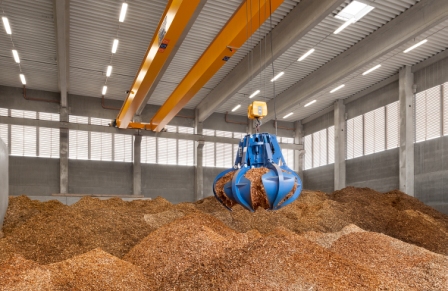Chippings or wood chips (or chippings) are wood that has been shredded using cutting tools. Shredded wood, on the other hand, is produced by shredding wood with blunt, shattering tools. Wood chips are primarily used as a raw material for the wood processing industry and as a biogenic and renewable fuel.
Depending on the origin, the terms bark chips or forest chips (wood chips) are also used.Chips are produced with chippers. Mobile or stationary disk, drum or screw chippers shred residual forest wood, weak wood and other low-grade wood (for example from thinning, cuttings from landscape conservation measures or waste wood), which cannot be processed into higher-quality products by the industry. With the increased establishment of short rotation plantations, these are becoming a source of raw material for woodchippings.
Wood chips consist of 100% wood. They have a calorific value of around 4.0 kWh (= 14.4 MJ) per kg (depending on the type of wood, with approx. 20% water content) and are suitable for automatically feeding, for example, heating systems using screw conveyors, spring tine discharges, push rod discharges (push floors) and conveyor belts.Depending on the tree species, various key properties of the woodchippings can vary and therefore influence the calorific value. This applies in particular to the water content, which has an important influence on the calorific value of the woodchippings and affects their storability. Woodchippings with a water content of less than 30% are considered "suitable for storage" and no or no significant microbial degradation of the woodchippings is expected. Freshly harvested wood chips, on the other hand, contain a water content of 50 to 60 %. Freshly harvested softwood has a calorific value of around 2 kWh/kg; with a water content of 20%, the calorific value is twice as high at around 4 kWh/kg
The bark content also has an influence on the quality of the woodchippings. If debarked wood is usually used for wood chips used as fuel in smaller wood chip heating systems, the lower-quality bark chips contain a higher proportion of bark. They are mainly produced from residual forest wood, weak wood and other low-grade wood (e.g. from thinning, cuttings from landscape conservation measures). They can be used for the production of chipboard or to generate energy in larger plants such as biomass heating plants or biomass cogeneration plants.

Chipped wood chip bunker with crane feeding (Gammel Engineering)
The European standard EN 14961 applies to wood chips, which specifies characteristic values and classes for water content, ash content, grain size distribution, bulk density, nitrogen and chlorine content and heating and calorific value of wood chips as a biofuel. In practice, classification according to the older Austrian standard ÖNORM M 7133 or the current ÖNORM C 4005 is also widely used in Germany.
Wood chips are mainly used as fuel in wood chip heating plants and -cogeneration plants, as well as in wood chip heating systems. They are usually fed using electric screw conveyors or scraper chain conveyors.
Smaller boilers usually require smaller, high-quality forest wood chips (size classes P16 and P45). Combined heat and power plants are more flexible in terms of raw material quality. The fuel costs are lower than those of comparable biofuels such as wood pellets or logs, but the need for fuel-specific processes must be taken into account.
Source : Wikipedia http://de.wikipedia.org/wiki/Hackschnitzel